Aquatic Myrtle: Walking Underwater Birds
Family Cinclidae and ecological requirements
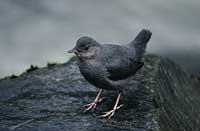
This passerine bird is classified in the monogenerative family of cyclides. In the genus Cinclus there are five species: Cinclus cinclus, popularly known as aquatic blackbird; Cinclus mexicanus, North American aquatic blackbird; Cinclus leucocephalus, equatorial blackbird; Cinclus schulzii, South American aquatic blackbird; Cinclus pallassii, East Asian aquatic blackbird. C. cinclus is the most widespread species worldwide, as it can be found in Northern Europe and throughout West, Northwest Africa and East Asia.
On the contrary, Cinclus schulzii is the smallest species with a more restricted range, only in western South America. The distribution area of Cinclus leucocephalus is limited to northwest South America. Cinclus mexicanus lives in western and northwest North America.
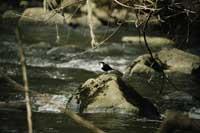
These five species, grouped in the same genus, exploit aquatic environments, fast and oxygenated stretches of rivers and streams. These sections have special ecological conditions and the aquatic myrtle have adapted to live there. Rivers and streams are not homogeneous means along its entire route. Therefore, we can distinguish between fast sections and slow sections with steep slope.
In these fast stretches, the waters that descend rapidly through jumps and narrow water present a concentration of oxygen at the saturation point. In the lower sections, on the contrary, the water speed decreases and the number of waterfalls decreases. It also reduces the oxygen content of the water. There are some species of birds that live by exploiting the energy resources of the high and low rivers. The most curious and striking is the kingfisher ( Alcedo athis), which thanks to its long and demanding beak, is able to capture the elusive fish of these river sections.
Adaptations of aquatic blackheads
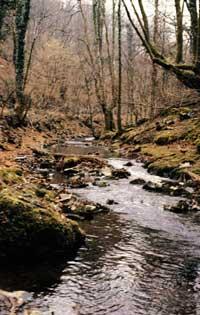
The aquatic myrtle has taken advantage of the development of a series of morphological characteristics to be able to live in these currents: it has reinforced the fingers finished with long and curved fingers to be able to travel the rocky bottoms of the rivers. In this way you can easily stick to the stones with long fingers or by putting your fingers into the cracks and stones. The beak, on the contrary, is short and robust to break the capsules in which the larvae of the tricopters hide, to be able to dump the stones in search of the larvae and obtain a hydrodynamic structure when immersed in the water.
The tail is completely reduced, perhaps because diving would make it difficult. Although the plumage of other birds is protective for water, aquatic blackbirds have reached their maximum level of protection. Most feathers in the body are protected by a fatty substance produced by the uropigial gland, located at the top of the tail of the bird. This substance, present in lipids and waterproof, does not allow to wet the dermis and sublingual feathers, although the bird is immersed in the water for 30 to 50 seconds.
But why is this bird doing such underwater excursions? The answer is found in the type of food that exploits the bird.
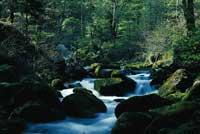
The aquatic myrtle feeds exclusively on invertebrates that inhabit clean rivers. Many insect larvae, such as tricopters, plekopterans, ephemeropters, dipterans, etc., cross the first stages of their biological cycle in rivers. This energy value offered by the river is exploited by different species, mainly fish, but also by water viewpoints. Therefore, we can observe the aquatic myrtle upstream and downstream on the banks of the river while moving small stones in search of food, since many insect larvae tend to be amazed to avoid the influence of the river water stream.
You can also see diving in deeper areas of the river. In addition to the beneficial protection offered by the plumage, it gives it a great buoyancy, so when going to dive takes advantage of the force of the water stream to deepen in the subsoil. Once in the background, it can reach between 1 and 1’5 meters deep, thanks to its long claws, holds the stones and travels the bottom of the river in search of possible insects in the rocks.
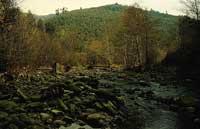
As mentioned above, the aquatic blackbirds that we can find in Europe have a striking white color on the chest, being all the brown plumage. The white pectoral color and the custom of the bird to fly at high speed through the surface of the water make it easily visible in clean areas of the river.
Biological cycle
Between January and February, the rivers and streams of Euskal Herria offer us the opportunity to enjoy the wedding flights of the waters. Throughout these months, couples dedicate themselves to delimiting the territory with parallel and direct flights along the river. Once the territory is settled, they are responsible for the construction of the nest. However, it is often not easy to decide where to locate it.
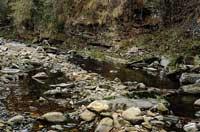
In the nest settlement area, areas with natural or artificial roofs are given importance to protect themselves from rains and other adverse weather factors. Therefore, many of the nests are built on bridges, although they can be built in other natural shelters, such as under natural walls, between rocks or in rocky holes. Also known is the custom of this bird to nest inside the waterfalls.
Under construction both sexes participate. The nest of the aquatic myrtle, which is usually spherical and is usually located on a riverbank or river, between 1-3 meters high on the surface of the water. The mosses, dried herbs and leaves that form the nest provide a solid structure. First they build the foot of the nest, being the strongest part. Then the side walls rise and at the end the roof. The entire structure is performed within 1 or 2 weeks. Although in the nest structure the moss plays a major role, the muscular layers of the outer walls of the nest are interspersed with dried grasses of grasses, which reinforce it. The inner depression is covered with dry leaves.
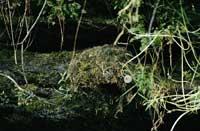
In some cases, the appearance of the nest may vary depending on its location. Nests built in natural sockets, for example, do not usually have a roof and we can question the identity of the builder, since they can be similar to other birds, such as the nest of common blackbirds.
In any case, the female lays 4 to 5 white eggs between March and April. During these months the aquatic blackbirds have their first txitada and the eggs remain in charge of the female during the 2-3 weeks that the incubation lasts. After this season, chickens are born and their parents start eating immediately, mainly larva trichopter. As chickens grow, parents interlace other insect larvae in their diet, mainly from plecopter and ephemeropter. After 2-3 weeks, the chickens are willing to leave the nest and if they find any danger, they have no doubt to jump from the nest to the water, as they are able to swim and dive, although they still do not know how to fly.
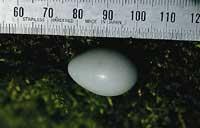
Parents will continue to feed for a few weeks and the first few days will reach the nest area to sleep. Towards the month of June comes the season of the second txitera (throughout the year there are one or two incubations, depending on the climate and the abundance of food). However, the members who make the second txitada will be able to continue feeding the chicks of the previous period, since they will not have to build nests (the same nest will be used as the previous one).
From the moment when the first and second breeders become independent of their parents, the river section in which they were born is abandoned and for 1-2 years will not settle in a specific section. After this period, they settle near the river of its maturity and birth, defending a new territory conquered of 1 km in length. Males are the ones who get the territory and try to conquer the females who can be next to them. Once a female is admitted, they begin the reproductive process, deciding first the position of the nest. Then the two newly assembled will fly through the territory showing their property.
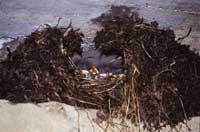
At the end of the time of Ugal, the couple does not defend the territory with as much courage as when it was numerous, and we can see it outside its territory.
60% of chickens born every year will not suffer the first winter, with a great life expectancy for those who have survived. This second year is the most decisive for the young look aquatic, because they have to fix the territory and find partner. In general, aquatic blackbirds live between 5 and 6 years. Therefore, if it only reproduces once a year, they can take 4 or 5 chickens throughout life.
The survival of chickens is not only limited by climate, but also by predators, who are very vulnerable while staying in the nest (especially with rats, armor, snakes and other animals). In adults, however, the influence of predators is scarce, with a great life expectancy for adults.
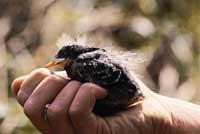
Numerous streams in the Northern Hemisphere are frozen in winter and because water hazards cannot get the food they need, they are forced to make small movements in the south direction. The small hole between the ice is enough for the bird to dive into the ground and get food. However, severe unforeseen freezing can cause a significant negative effect on the population of aquatic blackbirds, preventing access to food. In our latitude, however, it is not so, and in the harshest winters, they are able to pull forward the water blackheads.
Situation in Euskal Herria
Although aquatic myrtle can be found throughout the Basque Country, especially in the North, where the most suitable habitats are located, west of Bizkaia and east of Gipuzkoa. The physiognomy of the northern rivers is very appropriate for this diver, whose rivers are high current and sustainable water. On the other hand, the mild rainy climate of our territory is very appreciated by this paseriforme.
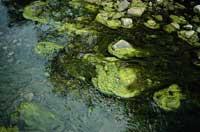
Although due to these characteristics, a large population of water viewpoints is expected in the rivers of our region, the reality is very different. Human beings have always had a tendency to transform the environment into their own benefit, today more evident. In recent years the transformations in terrestrial and aquatic media have been very intense. Specifically, the channeling generated in rivers, the elimination of riparian vegetation (elk and other species), the construction of reservoirs, the contamination of river waters, etc. have been totally inappropriate for the inhabitants of the place. The elimination of the riparian vegetation of the river alters the dynamics of the river, increasing the arcs, preventing the immersion of the aquatic blackbirds. They also appear invertebrates with more inadequate food.
The pipes that are carried out have also had a negative effect on the aquatic myrtle, since the turbulence of the water decreases in these sections, turning the flow into homogeneous current, which makes the channeled river stretch become an uncomfortable place for the invertebrates.
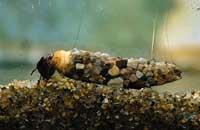
Another factor that influences the distribution area of the aquatic myrtle would be the collection of water in the dams. These dams cause interruption of water flow and lack of current. If we add to this the problem of increasing the depth, we can immediately understand that the water blackbird can not dive into it, so they can not access the food. On the other hand, the mini-hydroelectric plants that are being built especially in Gipuzkoa have turned the appropriate stretches of some rivers into uninhabitable areas.
However, numerous scientific studies have shown that the factor that has most affected this traveling submarine has been water pollution, which is very sensitive to pollution. The most polluted sections are the lower sections of the rivers, so it has already been discarded in the rivers to the springs and central channels.
All the transformation factors mentioned have made this beautiful bird, which in its day was probably abundant, a very rare bird.
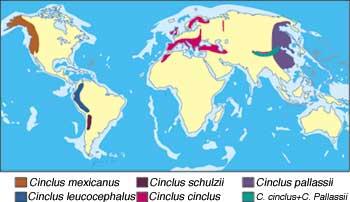
Buletina
Bidali zure helbide elektronikoa eta jaso asteroko buletina zure sarrera-ontzian











